‘‘Imagine,” Fred Schneider tells Uncut, “one week I’m washing dishes to make ends meet because I’d quit my job to do the band, and then the next week we’re flying to Nassau to record…”
At the Bahamas’ luxurious Compass Point Studios over three weeks in early 1979, The B-52s laid down their self-titled debut album. These five skint musicians were a bold signing for Island and Warners, even amid the excitement of post-punk: a deeply strange and subtly transgressive group, they shared as much DNA with the avant-garde, from Sun Ra to Yoko Ono to Captain Beefheart, as with surf music, girl group pop, disco and punk.
Formed in Athens, Georgia, in 1976, The B-52s had been nourished by the city’s unique environment. This was a farm town of eccentrics, led by the likes of Jeremy Ayers (later of Limbo District) and record shop owner William Orten Carlton, a place that welcomed outsider art and queerness.
From the start, The B-52s were unusual. They were a collective with no leader, a five-piece with three singers and no bassist (vocalist Kate Pierson handled keyboard bass along with organ) that sculpted songs via group improvisations, with a postmodern eye on the past. This was clearest in their look – all atomic bouffant wigs, shiny fabrics and garish makeup, a dazzling forerunner to the seedy Lynchian Technicolor of Wild At Heart or Blue Velvet – but also in their music, which blended surf, punk and underground experimentation with the novelty weirdness and outer-space obsessions of the 1950s.
They were kitsch, certainly, but surreal and absurdist rather than camp or ironic; an American response to Roxy Music’s high-art trash aesthetic. Yet these were the days when bands as bizarre as The B-52s could find a home on major labels, and Island and Warners’ bet paid off.
To say that their catalogue – now being reissued in this 9LP or 8CD box, minus 2008’s Funplex – starts strong would be an understatement: The B-52’s is a stunning debut, a hermetic manifesto that appeared out of the ether. Its first side in particular is near-perfection: from the ragged space-garage of “Planet Claire”, with its “Peter Gunn” riff, and the breakneck, proto-Strokes “52 Girls”, to the swinging chaos of “Dance This Mess Around”.
Side One’s closer, “Rock Lobster”, is the album’s crowning glory. Seven minutes of demented garage built around a detuned surf riff, with absurdist lyrics about a beach party, it evolves into a savage outro showcasing guitarist Ricky Wilson’s genius. Involving detuned, missing and unison strings, his novel technique – part Ventures, part Magic Band’s Zoot Horn Rollo, part Sonic Youth before Sonic Youth – allowed him to play slashing parts that still sound like little else, and hit harder than most punk or no wave. With Schneider handling declamatory spoken word, The B-52’s, especially “Rock Lobster”, shows off Cindy Wilson and Kate Pierson’s Ono-esque vocal experimentation, and famously inspired John Lennon to call Ono from Bermuda to tell her that her “time had come”. Double Fantasy was the result.
Producer Chris Blackwell sensibly kept the arrangements minimal and the sound dry on The B-52’s, mimicking the band’s shows, which gives the record a beautifully crisp feel. Rhett Davies was similarly strict on the follow-up, 1980’s Wild Planet. Despite songs about poodles called Quiche and demonic cars, there’s plenty of edge: “Party Out Of Bounds” is interspersed with eerie discord, the raunchy “Dirty Back Road” doesn’t hide very hard behind its driving metaphor, and single “Private Idaho” is consumed with paranoia, Schneider warning over one of Wilson’s finest riffs: “Don’t let the chlorine in your eyes/Blind you to the awful surprise/That waits for you at the bottom of the bottomless blue, blue, blue pool…”
The B-52’s and Wild Planet used up their pre-fame material, and now the group needed fresh songs. To buy some time, in July 1981 they released Party Mix!, a pioneering yet inessential remix album that squashed three songs from both LPs into side-long medleys. In the meantime, they were recording with David Byrne, but various difficulties meant the results were trimmed to a mini-album, 1982’s Mesopotamia. Their attempts to fill out their sound with horns, synths and the like don’t always succeed, but the Levantine disco title track remains a fine example of their interlocking vocal parts, overflowing hooks taking the place of traditional choruses.
The group changed their process for 1983’s Whammy!, with Ricky Wilson and drummer Keith Strickland handling all the music on drum machines, synths and guitars. Jamaican engineer Steven Stanley, one of the sonic wranglers on Party Mix!, produced the delightfully out-there results. While they embraced electronics, this wasn’t your usual mid-’80s sound: the frantic likes of “Whammy Kiss” and “Butterbean” are more akin to Suicide covering Beefheart at Black Ark.
“Song For A Future Generation” was a bizarre, brilliant single, each of the group delivering a spoken verse about themselves, then coming together to trill “let’s meet and have a baby now”. Whammy! originally included a cover of Ono’s “Don’t Worry…”, unfortunately replaced with the inferior “Moon 83” on subsequent pressings, including this one.
Things began to go wrong for The B-52s about now. Ricky Wilson became ill with AIDS, keeping it a secret from all but Strickland, while relationships in the band fractured. When Wilson passed away in 1985, Bouncing Off The Satellites was practically finished and was released the following year with no active group and little promotion. Perhaps unsurprisingly, only the joyous, rockabilly-powered “Wig”, reworked from a decade-old jam, captures their usual zest.
No-one could replace Wilson, so the new songs the group wrote when they reunited later in the decade were less manic, less experimental, but more soulful and in tune with the times. As a result, 1989’s Cosmic Thing became a huge hit, one of the best-selling albums in the US that year. It was a warm, welcoming record: the group looked back fondly on their Athens days on “Deadbeat Club”, and indulged their interstellar fixation on “Topaz” and the title track, even while “Channel Z” took shots at political “disinformation”. Granted, the snare sounds were gargantuan, but that was hard to avoid in 1989.
Similarly inescapable was “Love Shack”: if it suffers somewhat from overfamiliarity these days, it’s nevertheless a playful piece of Southern groove, with Schneider, Wilson and Pierson’s vocals freeform and vital.
1992’s Good Stuff has its moments – “Is That You Mo-Dean?” was another space classic – but suffered from the absence of Cindy Wilson, overlong tracks and increasingly slick production from Don Was and Nile Rodgers. The B-52s would later perform the title song for 1994’s The Flintstones – a peak in visibility, a dip in quality – tour extensively and, in this decade, enjoy residencies in Las Vegas.
While there’s something very B-52s about Nevada’s atomic testing sites, casinos and tacky Strip, Vegas is still an unexpected destination for a group so conceived in the underground; yet it’s perhaps no weirder than Bryan Ferry, a fellow explorer of the kitsch and the curious, staking out his patch on Smooth Radio.
The B-52s have been calling themselves “the world’s greatest party band” for years now. They’re not entirely wrong, of course, but the Athens troupe are so much more than that. For one, the way they’ve lived their lives and presented themselves has long been an example to marginalised outsiders, whether queer or otherwise. And the music collected here – especially their effervescent debut – has inspired acolytes from Beat Happening to Boy George, Sleater-Kinney to Stephen Malkmus, not to mention Lennon and Ono. As this box charts, they’re one of those rare groups who can genuinely claim to have launched the counterculture gloriously into the mainstream.



